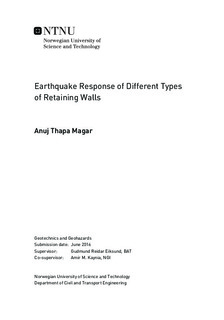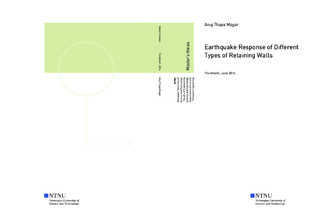| dc.description.abstract | Retaining walls are designed to restrain against the lateral earth thrust while keeping its original position intact. During an earthquake, the lateral earth thrust increases and the walls become susceptible to failure which has resulted in frequent damages of the walls. This thesis studies the earthquake response of different types of retaining walls where a comparative study of these walls have been carried out in terms of the stability and performance under the earthquake excitation with the help of a finite element program, PLAXIS 2D. The different walls analyzed are the gravity, gabion and cantilever wall. In addition, parameter studies have been performed for a gravity wall to understand the effect of different parameters.
Prior to the analysis on the retaining walls, two different tests have been performed for analyzing the boundary conditions. To verify the model in PLAXIS, the results have been compared with the test results of the physical shake table test of a scaled retaining wall.
For the parameter studies, there different height of the wall (3.5, 4 and 5 m), three different backfill angles (32 ̊, 35 ̊ and 38 ̊) and three different backfill slope (1/15, 1/10 and 1/5) with four different PGA levels (0.05g, 0.1g, 0.15g and 0.2g) have been taken. For the variation of earthquakes, three different earthquakes have been used. The results are compared with the total force on the wall and the permanent displacement of the wall for different cases. The total force and the displacement of the wall increase with the increase of the wall height or backfill slope whereas decreases with the increase in the backfill friction angle. The total force from the PLAXIS is also compared to that from M-O method which showed a large variation. It again highlighted the fact of M-O method being a conservative design method but with more appropriate input acceleration, the performance of the M-O method can be improved.
The comparative study of different walls showed that the total force for the gabion wall is lower than the gravity wall while the cantilever wall has the lowest total force. Also, the permanent displacement is lower in the gabion wall than the cantilever wall whereas the gravity wall has displaced the most in all the cases. Overall, the cantilever wall provided the better stability and performance under the earthquake excitation for the wall height of 4 m and PGA level up to 0.2g. In addition, considering the cost effectiveness, construction easiness and material volume, cantilever wall could be the most appropriate solution among the three types of retaining walls. Furthermore, the gabion wall also showed good anti-seismic characteristics and performed better than the gravity wall. The future work could be to perform more parameter studies such as the different height of the wall and higher PGA level than 0.2g for analyzing different walls. | |

